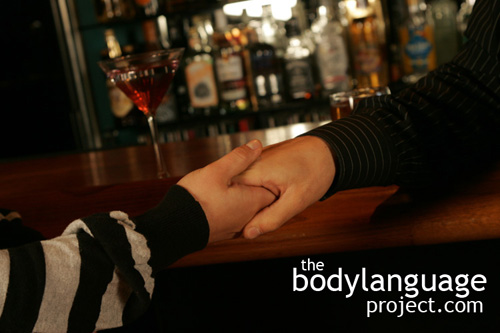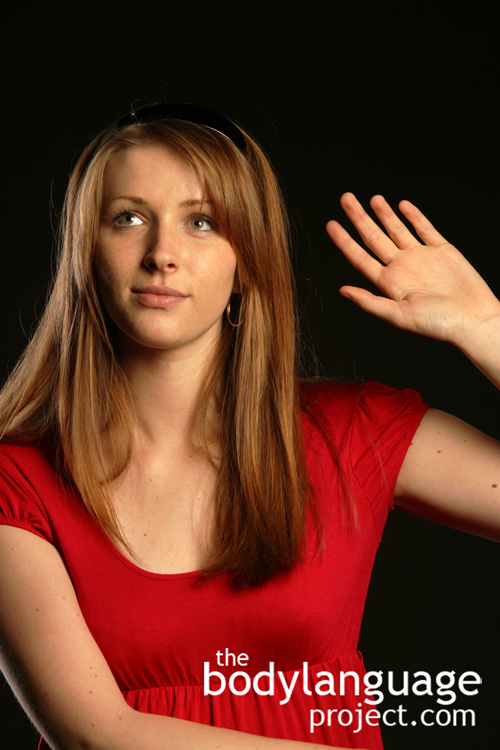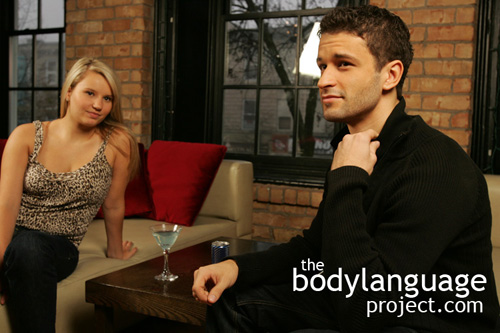In this third chapter we examined and compared the various influences on body language: genetic, learned and cultural. We found that in terms of genetics we all show similar roots and so display similarly across cultures, but that learning does play a role in how we might signal. We also covered emblems, illustrators, affect displays, adaptors and regulators which all form a part of what is called kinesics or how nonverbal behaviour relates to movement. Emblems, we found, are quotable gestures that are culturally specific which can be used as replacement for words and have a direct verbal translation. Illustrators are a second type of gesture that we use while speaking to help us paint a more descriptive picture such as talking about a boxing match and using a punching motion. Affect displays is nonverbal language that reveal our emotional state such as smiling or frowning and adaptors are movements or gestures that are used to manage our feelings or control our responses such as postural changes. Sometimes these adaptors have hidden meaning, but other times they do not, so caution is warranted. Regulators on the other hand control turn taking and flow when people speak with one another. Finally we covered high and low context cultures as it relates to touching and the ways various cultures meet and greet one another.
Chapter 3 – Cultural Differences
The Ways Cultures Meet And Greet
by Chris Site Author • March 5, 2013 • 3 Comments
Bowing is a courtesy gesture that is performed by bending the waist at about fifteen degrees and occurs between members of about the same age and status. Bending to a full forty-five degrees is reserved to show the highest degree of politeness which you might show to someone of particularly high social status. The general rule applying to bows says that the lower ranking individual bows first, further and longer. In very casual settings a simple head nod would suffice. Still, in other settings, a handshake might accompany the bow and this is fast becoming the norm in Chinese society. The bow has origins related to status since it leaves the head vulnerable to attack showing trust. In Muslim and in Judaism the bow is seen as a gesture between God and his people, and is therefore frowned up as a gesture between those of equal status. In European cultures, the bow is used by men alone, whereas women perform their version, the curtsy, where the leg is tucked behind the other followed by a slight dip. Bows are traditional in Korea, Japan and to some degree China though not as formalized.
The full salaam is a traditional greeting in Arabic speaking countries and Islamic countries but of which is losing popularity. It is done by sweeping the right arm upwards from the heart above the head. It begins by placing the hand in the center of the chest over the heart, palm to chest, then moving upwards to touch the forehead, then rotating the palm out and up slight above head height in a sweeping motion. In the abbreviated salaam the head is dropped forward or bowed and the forehead, or mouth, or both, is touched with the fingertips then swept away. The namaste is a greeting done in India by placing both hands together palm to palm across the chest and bowing slightly. It’s origins like the handshake and wave demonstrates that no weapon is present.
Cheek kissing is another greeting gesture common in certain parts of the world. Kissing is common in Switzerland, Southern Europe, the Mediterranean and Latin America. Italians, Hispanic and French establishments will also kiss hello even while living in North America. Other pockets of kiss hellos’s are located in Miami and also Quebec where there is a heavy influence of Latin American and European immigrants. Others who kiss include Scandinavians who use a single kiss, the French who use the double kiss, and the Dutch, Belgians and Arabs who use the triple kiss. The kiss hello occurs when both people lean forward and either lightly touch cheeks together or where the lip partially touches the check. Generally the person will simply kiss the air rather than the actual cheek. Many variations exist of who kisses who and how. For example, women would kiss women in Southern Europe and women would kiss men, but men kissing men varies specifically from country to country. In Argentina and Uruguay, however, it is fairly common for male friends to kiss.
Fast becoming the most common type of greeting is the handshake as it represents the middle ground between the kiss and the bow. It contains some intimacy in the form of touching but stops short of being too intimate for most cultures. Even with respect to the handshake there are differences across cultures. For example firm handshakes are welcome in the West but in Asia are seen as aggressive. In parts of East Asia and North America, women and children rarely initiate a handshake, but will usually oblige if offered, and in Islamic countries men never shake the hands of women. Across the world a handshake is most commonly done with the right hand, but is far from universal.
The French lead the world in the handshake department and have been shown to shakes hands for up to thirty minutes a day. Shaking hands is common for the British, Australian, Canadian, American and German. Variations of the number of pumps also exist with some cultures shaking hands up to seven times. For example people from Northern Europe pump hands up and down only once and those from Southern Europe and Latin America pump hands up and down longer and with more vigor. Other cultures, still, will continue to hold the hand even after the handshake is complete which is common for Indian, Asian and Arabic cultures. If not prepared, this intimacy can be disconcerting and one might be driven to pull their hand free.
Hand kissing is another ritualistic greeting, but one that is nearly extinct today. It was common in the European upper class in the 18th and 19th century. The hand kiss was a form of respect given to someone of high class by someone of lower class. The palm was presented face down to a subordinate and he or she would bow forward and kisses the knuckles or ring. It is still observed in Central Europe such as Austria, Poland, Turkey and Hungary. Other greeting gestures are the kowtow from the Chinese which happens by kneeling and bowing so low as the head nearly touches the ground, the hongi, a traditional greeting in New Zealand where the noses are pressed together and hugging which is more common among friends and family in North America, but more universal in Latin America even amongst men, and in Russia where we see firm handshakes followed by big hugs called “bear hugs.” Polynesians can be seen following up hugs with back rubbing. In North America where greeting gestures are less formal, the fist pound happens where two fists are brought together as if punching each other. Less intimate greetings include waving, hat tipping or “doff” (which is mostly obsolete) and hat raising common in the 19th and early 20th centuries.
If you find yourself touring a foreign country who’s culture is very different from yours, but find someone bringing you in closer to hug, kiss a cheek, or hold a hand, don’t pull back. If someone wants to hold your hand, don’t wince, or twist it away, or if someone shakes your hand for what seems like far too long, don’t give up part way. These cultural traditions are no worse than yours and since it is you who is invading someone else’s territory, it is you who deserves to respect your host’s customs and not them yours. Being welcomed by native people with their traditional greetings is their way to make you feel at home, even if it violates your personal space requirements, or makes you uneasy. The same can be said for greetings from the elderly whom I find routinely hang onto a hand after shaking to keep close. Remember that an intimate greeting is a sign of respect and it should be honoured from whomever it comes from, and in what way.
High/Low Context, Culture And Touching
by Chris Site Author • March 5, 2013 • 0 Comments
The term “personal space” was first used by psychologist Robert Sommer in 1969 to describe the comfortable zones that people like to keep around them. His observations stemmed from the uneasiness experienced by hospital patients when he encroached on them. Further research into personal space has found that closeness tolerances vary by culture, and so too does touch. For example, Americans tend to prefer large amounts of space whereas Latin Americans, Italians and Middle Easterners require far less. Americans come from a culture with what is called “low context” and those from the middle-east come from “high context” cultures. In a high context culture the rules for conduct do not have to be specifically outlined or verbalized because everyone already knows them. Thus, in a high context culture the rules are set and the countries demographics doesn’t vary widely from person to person. High context cultures have a long standing history so practically everyone in the country understands the rules of touching. In a low context culture, where the individual is valued more than the that of the whole, touching is far less frequent or tolerated. In a low context culture the content of speech is delivered through words instead of touching. Examples of low context cultures where touching is infrequent includes America, Germany, Japan, United Kingdom, and Australia. High context countries where touching is more frequent includes the Middle East, Asia, Africa, Italy, Latin America and South America. Middle ground countries include France, China and India.
A business man from Australia visiting Italy or France can be shocked to have a potential business partner touch over coffee to emphasize a point. Those unaware of their host’s cultural norms could misrepresent touching as a sexual advance especially if your company is of the opposite sex. Then again, touch avoidance might also be misconstrued as rude or standoffish to a high context culture. An attempt should be made to follow cultural norms out of respect so in a high context culture one must fight the natural urge to pull back to avoid offending and in a low context culture we should respect their need for privacy and personal space by limiting touching.
Here is a quick breakdown of countries by touch tolerances:
[A] English-speaking countries (Canada, United States), Australia, Japan and northern Europe. Avoid casual touching.
[B] China, France, India. Accept some casual touching.
[C] Latin America, South America, Africa, the Mediterranean, Middle East, Italy, Russia and parts of Asia. Freely use casual touching.
Some Gestures Are Universal
by Chris Site Author • March 5, 2013 • 0 Comments
Smiles which signify submission and enjoyment to others are a great example of a universal expression. As mentioned not all gestures, however, have a universal origin, but one that does is the shoulder shrug. The shrug is done by bringing the shoulders up, drawing the head in, and turning the palms upwards so as to reveal that nothing is hidden. The shoulder shrug can also demonstrate submission or that what is being said isn’t understood as in “I don’t know” or “I don’t get it”. Pointing finds its place all over the world to indicate direction or to emphasis a point. However, even the pointing gesture shows variation across culture as some will point with the index finger, others will use the middle finger and yet others still will point with a closed fist and use the thumb to indicate. Most cultures find pointing rude altogether, but others are more tolerant of its use. Where the middle finger is seen as a rude gesture, using it to point can be extremely off-putting and should be avoided.
Another gesture that has roots in various cultures is the beckoning signal whereby the index finger is curled upwards repetitively, with the palm facing up and the remaining fingers clenched. It means “come here”. In Africa and Spanish speaking countries the entire hand can be used and includes all four fingers whereas in Sicily the entire hand is waved palm down in a sweeping motion as if to drag the person in. The Japanese have a similar gesture, but the four fingers are used with the palm facing the target and is placed at head height. The fingers are then pulled inward toward the palm. To Americans and Europeans, it might be confused with waving rather than beckoning primarily due to the height of the hand. This gesture is found in the Maneki Neko which is the “beckoning cat” a symbolic figure. The beckoning cat also translates to the welcoming cat, lucky cat, money cat or fortune cat.
Most gestures, however, are heavily culturally driven and are therefore learned. They are transferred through time by their use. Gestures are obvious to locals, but to visitors the gestures often means something else altogether. With globalization and ubiquitous media the nonverbal gap is shrinking all the time. If the trend continues gestures will become more and more universal. As regional medias become more uniform, so too does the body language. Even a country kid knows how to act in a congested downtown city core from what they’ve seen in movies and on television. Even isolated rural cultures including native tribes, absent of modern media are seeing more and more visitors via tourism every year serving to assimilate their gestures.
Culturally Our Bodies Are All Basically The Same!
by Chris Site Author • March 5, 2013 • 0 Comments
Most researchers agree that the following six emotions are recognized by all cultures: happiness or enjoyment, distress or sadness, anger, disgust, surprise and fear. However, positions the body takes on to demonstrate these emotions vary across cultures. Since every person on the planet regardless of race or creed has the same underlying emotions and our body language is tied to our feelings, it follows that every person’s nonverbal language has similar roots, but like verbal language we don’t express ourselves exactly the same. Paul Ekman from the University of California has done extensive research into facial emotion recognition and has found just that, everyone across the planet is almost the same.
Happiness, sadness, and disgust had the best agreement between cultures, whereas fear and surprise tended to be confused, especially by the Japanese. Another rural population, the Dani people of West Iran, who are generally isolated from the rest of the world, showed a similar confusion between fear and surprise. Surprise is read as a straight upward lift of the forehead whereas fear engages the muscles between the brows folding them. The French call the area between the brows, the “grief muscle” and is active to express both pain, as well as when you wish to inflict it. The fearful face carries a momentary raise in the upper eyelids and a grimace comes across the mouth. Anger appears with a lowering of the eyebrows, flaring of the eyes and a tightening of the mouth or jaw. Fear, grief and surprise in addition to other facial expressions can quickly flash across the face in the form of micro expressions. Being aware of them can rouse opponents and in poker indicate ‘tells.’ As people check their hidden cards, be sure to watch for split second reactions.
Members of the Fore linguistic-cultural group of the South East Highlands of New Guinea whom had never seen movies, who did not speak English and had never worked with a Caucasians before were also able to read facial expressions accurately. Studies show that even blind children score similarly to sighted children in terms of facial expressions. Further research by Paul Ekman showed that a contempt expression was also none culturally specific and was recognized by Estonians, Germans, Greeks, Hongkongese, Italians, Japanese, Scotts, Turks, Americans and West Sumatrans. Ekman traveled to a remote population in the mountains of Papua New Guinea where there is no television, DVDs or movies yet found that facial expressions remain universally understood. Once there he filmed the expressions of the population and found that upon his return were also understood by Westerners.
With very little exception, facial expressions are universally recognized. What does differ from culture to culture is our surroundings; our habitat and traditions. Greater differences therefore lie in our territoriality, level of eye contact, and touching norms. These factors tie back into the density in which we reside, and also into our comfort tolerances and preferences due to our upbringing. Gestures are mostly learned and passed from one person to another and are thus not universal across cultures. Gestures are more similar to verbal language. Because language and gestures are transferred over time they also evolve.
How To Use Regulators
by Chris Site Author • March 5, 2013 • 0 Comments
Regulators, regulate speech and control turn taking. Literally we can increase or decrease the amount of talking that happens with simple body language. For example, to increase speaking add more nodding. When people stop and you wish for them to continue simply nod your head, and, more often than not, this will encourage them to begin speaking again. The use of “mhums” and “yeses” will have the same effect. To speed speech up, or end a conversation altogether, send frequent looks away or down to your watch.
Too much nodding, on the other hand, shows indifference which can be a useful tactic depending on the speaker and your intent. Three nods in quick succession shows that you are ready to speak yourself and has the net effect of increasing their rate of speech to avoid being cut off. Drawing in air and parting the lips while tilting the head back slightly also gives the impression that someone is prepared to speak, as does patting the mouth with two fingers. Looking at your watch or looking to the doorway will make people talk less or if done excessively stop altogether.
Try this experiment. As your conversation begins nod your head every few seconds or as you see agreement. Next, increase the rate at which you nod your heard regardless of any agreement. What happens when you increase your nod frequencies? Most likely, up to about two to three continuous nods, they will become more excited believing they are building rapport. What if you nod continuously? I suspect it will stop the conversation altogether. Recall that three quick nods means that you wish to interject, while continuous nodding comes across as feigned agreement sending the conversation into a standstill. What happens with appropriate nodding absent of proper eye contact? This signals to others that their conversation is falling on deaf ears, and will be taken as an insult. The same goes with random nodding that has lost synchrony with speech. Telephone conversations easily fall off their rails if one party becomes preoccupied with another task. We immediately sense that their regulators have become unlinked from the conversation and when it comes time for them to speak, we hear nothing in return, or there is a delay. Not surprisingly, we find that the person on the other end is watching television – an obvious insult.
When people near the end of their though, and wish for their partner to speak, they will often lower their volume and slow their voice down slightly. Other times, the final syllable will be drawn out or gesturing with the hands will become less frequent or stop altogether. The eyes too are often lowered along with the head but at the very last moment eye contact will resume indicating that it’s time for the other person to begin speaking.
Raising the index finger can also signal a desire to speak which we learn early on in grade school which is normally accompanied by a sharp and deep intake of air. To stifle the “index finger interjector”, extend your hand across and make light contact with their forearm. This is a polite nonverbal way to show that you acknowledge their desire to speak, but that you haven’t quite concluded your point. If you sincerely wish to communicate interest and increase speaking, add a slight head tilt and a half frown or half-smile. This shows the speaker that what they have said is unclear but that you otherwise find it fascinating and wish to learn more.
Good communicators will make great partners amongst all types of speakers, even those that seem to carry on endlessly or those with little to say. They will have a strong arsenal of tools to cut one set of speaker off nonverbally, or as the case may be, encourage them to speak further. While we may take regulators for granted, conversations would be awkward and disjointed without them. Experiment a little for yourself and see how you can modify behaviour with regulators to suite your needs.
Regulators, Regulate Speech
by Chris Site Author • March 5, 2013 • 0 Comments
The final type of gestures are called regulators because they are used to modulate and maintain the flow of the speech during conversation. Essentially, we use regulators to control turn-taking in conversation and they can take the form of kinesic such as head nods or nonkinesic such as eye movements. Regulators are different across cultures more so than any other element of body language discussed thus far.
In a study by Marjorie Vargas in 1986, it was noted that black students in the United States felt insulted by the white educators. The educators weren’t picking up on cues that the students understood what was being instructed. For example, the white students would nod and murmur “uh-huh” but the black students would nod much less and use “mhm” instead. The teachers took this to mean that the students didn’t fully understand the material, but this wasn’t so, they just expressed their understanding differently.
In Japan, the up and down nod of the head or “yes motion” is utilized not to show ‘agreement’ but to show ‘understanding’. Therefore, while pitching a new idea or venture, it would be foolish to think that the continuous head nodding by the Japanese was do to their willingness to invest. Creating a simple dos and don’ts list is not feasible for these nonverbal kinesics in speech for the simple fact that there are far too many to list and the variation of meaning across culture is so varied. With the simple awareness of emblems, illustrators, affect displays, adaptors and regulators the incidence of misinterpreting their meaning can be reduced.
Caution is therefore important when dealing with international business so as to avoid any harm in interpretation. Some other examples of regulators include putting the hand up to signal that you are ready to speak, putting the finger up to the mouth to bring silence, waiving the hand around in a circle so as to speed things up, rolling of the eyes showing disapproval, a gasp to show shock, throwing the hand to someone to include them in the conversation, or shaking the head disapprovingly. All these gestures control the flow and pattern of speech by directing, disapproving, speeding things up or slowing them down, and even cutting the speaker short.
Using regulators in speech is necessary to create seamless turn-taking and to avoid appearing rude, dominating or frustrating the people you are talking with. It prevents having to interrupt, eases the flow of speech and allows everyone to make the points they wish to make without having to cut each other off mid-sentence. The net effect of a good conversation is connectivity through the creation of seamless turn-taking.
Adaptors
by Chris Site Author • March 5, 2013 • 0 Comments
Adaptors are movements or gestures that are used to manage our feelings or control our responses. Adaptors include movements done to improve comfort or reduce stress and often happen at such a low level they usually escape awareness. Adaptors include movements such as shifting in a chair or postural changes, crossing the legs, pulling at a shirt collar, adjusting a tie, loosening clothing and so forth.
What is interesting to researchers is that some adaptors serve a real purpose and others indicate stress. For example, sometimes our pants really are uncomfortable so we scratch our legs, other times the stress from outside pressure causes us to scratch in an effort to displace energy and distract us. Crossing the legs toward your date might be read as an indicator of interest, but might instead serve to alleviate numbness from loss of circulation. Children will rub their eyes repeatedly when tired, but this is not because they become itchy!
Scratching the nose is another example of an adaptor and could be misread as an indicator of a lying or might actually serve to relieve an itch. Another common adaptor used by adults is the head-grooming gesture where the hand messages the back of the neck or head to relive stress. This gesture is not an authentic gesture motivated by a physical purpose. Rather it used as a method to achieve comfort when facing discomfort applied from the outside. Just about every cue related to body language can be an adaptor. Arm crossing, leg crossing, scratching, fidgeting, twitching, rubbing the eyes, and so on, are all part of the human repertoire and not all have hidden meaning all of the time.
It is the job of the body language reader to decide which movements are motivated by a real physical purpose and which are motivated by an underlying emotional purpose. Usually stress release methods are person specific so once they are detected can be reliable as predictors in future encounters. Some might pull an ear lobe, rub one’s throat, pull on a collar or scratch the back of the hands. I will say that it’s usually pretty obvious when a gesture like scratching is real because it is targeted, quick, non-repetitive and provides instant relief, but when it’s as a response to emotional trauma, it show opposite characteristics. It is general in nature, perpetual, repetitive and provides no discernable relief (at least not instantaneously). The context, meaning high or low stress environment provides strong clues to the purpose of the adaptors. All proper body language reads should take context into consideration.
As we see, movements or adaptors come in two forms. They either have hidden meaning, or they do not. Plenty of emphasis has been given by researchers on these subconscious clues on the grounds that they would unlock secrets. However, the importance placed on adaptors is probably overstated and oversimplified. The real goal of the body language reader is to decipher the difference between adaptors with no meaning and movements and gestures that have actual meaning. Adaptors in cross-cultural meetings can also be potential landmines. For example, emblems, specifically because they are culturally engrained, are emitted without conscious thought. Many Arabic countries see the sole of the foot or the figure-four-leg cross as offensive and rude (an emblem of sorts to them) so they may classify a Westerner as something they intent not to be. It is clear to the Westerner that they wish only to take up a more comfortable seating position. The take-away message is to treat adaptors with the care they deserve instead of jumping to inaccurate, embarrassing or even disastrous conclusions.
Recognizing Body Affect By Culture
by Chris Site Author • March 5, 2013 • 0 Comments
In 1969 researchers Albert Mehrabian and John Friar found that a person’s state, their mood, and their emotional state were reflected by changes in body positions. In this context we are referring to affect in terms of simple gestures like leg crossing and arm crossing to indicate a closed mind or palms up and arms uncrossed to show openness or a willingness to listen. In fact, most of this book covers body affect and systematically breaks it down in future chapters. This cultural discussion is therefore important in that it describes the universality of body language.
While little research has focused specifically on measuring emotion from body positions, it has been found that the central nervous system is responsible for perception of emotion and this emotion is fed back into our body’s machinery to produce affect. The ways in which people convey emotion through body positions (or affect) is mediated by many factors including age, gender and context. Despite these factors though, body positions due to emotion, also has a cultural component. It is generally agreed that the face holds particularly universal expressions in terms of emotions as mentioned in the previous section, but the remaining language spoken by the body seems less obvious.
For example, the Japanese tend to be less expressive with their body language overall and therefore rate others more intensely on their nonverbal language. In a 2006 study by Andrea Kleinsmith and her colleagues out of London it was found that even mild expressions were rated as more emotional by the Japanese subjects over the ratings of other cultures on the same affect. A Westerner in the eye of the Japanese appears like a flailing uncontrolled windmill with their arms moving about as they gesticulate while they speak, whereas the Japanese appear rigid and uptight to a Westerner. In the study however, the meaning behind body language was still rated similarly across all cultures showing that emotion does have universal traits and crosses cultures. Thus, while the amount of affect does vary across cultures, the meaning behind the body language crosses boarders.
Affect Or Emotional Displays
by Chris Site Author • March 5, 2013 • 0 Comments
Affect displays is subset of nonverbal language that reveal our emotional state. For example, if we are happy we can show enthusiasm, or if we are telling a sad story, we correspondingly show somber. Affect display include facial expressions such as smiling, laughing, crying or frowning.
Awareness of various kinds of affect and how it is used in speech will provide vital clues about the speaker and his or her intent. Affect displays occur in synchrony and within the rhythm of speech. They emphases certain words or phrases and are an integral part of speech and thought. They can tell us about the expressiveness of a person and also what they find most important in their speech by which words they choose to emphasize. Posture can also signal emotion as can a variety of other gestures.
Affect is also different from culture to culture. For example, Russians tend to smile much less than Americans and therefore an American might come across as overly friendly to a Russian. Conversely Russians might come across as disinterested or aloof to Americans because they smile less frequently. In reality, both cultures are neither aloof nor overtly content, they simply appear to be so as they are viewed through a complimentary cultural norm bias. There is no right or wrong way to display affect, which is to say that no culture is better or worse because it smiles, frowns or cries less or more than another during expression.











